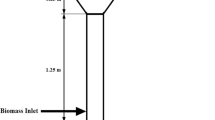Abstract
A thermal model for a conventional biogas plant has been developed in order to understand the heat transfer from the slurry and the gas holder to the surrounding earth and air respectively. The computations have been performed for two conditions : (i) when the slurry is at an ambient temperature of 20°C, and (ii) when it is at 35°C, the optimum temperature for anaerobic fermentation. Under both these conditions, the gas holder is the major “culprit” with regard to heat losses from the biogas plant. The calculations provide an estimate for the heat which has to be supplied by external means to compensate for the net heat losses which occur if the slurry is to be maintained at 35°C. Even if this external supply of heat is realised through (the calorific value of) biogas, there is a net increase in the biogas output, and therefore a net benefit, by operating the plant at 35°C. At this elevated temperature, the cooling effect of adding the influent at ambient temperature is not insignificant. In conclusion, the results of the thermal analysis are used to define a strategy for operating biogas plants at optimum temperatures, or at higher temperatures than the ambient.
Similar content being viewed by others
Abbreviations
- As :
-
half of the area of the skirt of gas holder
- At :
-
area of the top surface of gas holder
- Aw :
-
circumferential area of the slurry pit
- a, b:
-
constants
- Cp :
-
specific heat (kcal/kg °C)
- h1- h5 :
-
convective heat transfer coefficients (kcal/m2 hr °K)
- T:
-
temperature
- t:
-
time
- α, α1 :
-
absorptivities at short wavelengths (for solar incidence)
- ∈, ∈′:
-
emissivities at long wavelengths
- σ:
-
Stefan-Boltzman constant
- A:
-
ambient
- D:
-
gas holder drum
- G:
-
gas inside the drum
- S:
-
slurry
- ∞:
-
soil under the surface
References
Berkat H Z & Clark J A 1966Proceedings of 3rd International Heat Transfer Conference,2 152
Eckert E R G & Drake R D 1974Heat and mass transfer (TataMcGraw Hill)
Hill J E, Kasuda T, Lin S T & Powell F J 1975A proposed concept for determining the need for air conditioning for buildings based on building thermal response and human comfort, NBS Report BSS-71 (National Bureau of Standards)
Kasuda T & Ishii K 1977Hourly solar radiation data for vertical and horizontal surfaces on average days in United States and Canada, NBS Report BSS-96 (National Bureau of Standards)
Khatry A K, Sodha M S & Malik M A S 1978Sol. Energy 20 425
Meynell P J 1976Methane: Planning a digester (London: Prism)
Prasad C R, Krishna Prasad K & Reddy A K N 1974Economic & Political Weekly 9 1347
Ramakrishna Rao G, Ramamohan R V & Ramana Rao B V 1977Ann. Arid. Zone 16 5
Author information
Authors and Affiliations
Rights and permissions
About this article
Cite this article
Prasad, C.R., Sathyanarayan, S.R.C. Studies in biogas technology. Part III. Thermal analysis of biogas plants. Proc. Indian Acad. Sci. 2, 377–386 (1979). https://doi.org/10.1007/BF02848934
Received:
Revised:
Issue Date:
DOI: https://doi.org/10.1007/BF02848934




